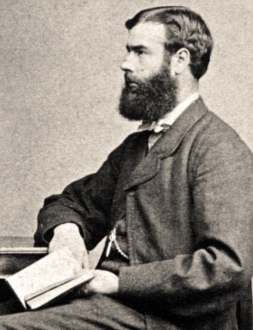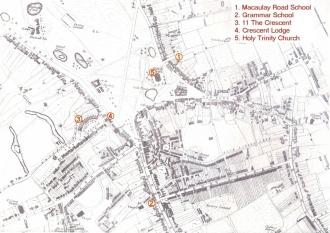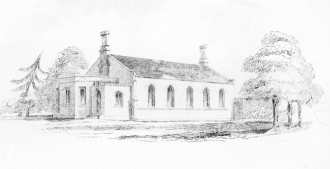The Clapham Society Local History Series 8
Francis Kilvert and Charles Pritchard
Clapham Connections
by John Toman BA BPhil DASE DipEd
They talked of Planets as they roll,
Of Nature’s wise mysterious whole.
[Sophia de Chièvre, writing of her husband’s friends in the Bath Literary and Philosophical Association]
Kilvert Family and Clapham
The illustrations: Please click on thumbnail to see a larger version.
Links between the Victorian diarist, the Rev Francis Kilvert (1840-79), and Clapham were reported in two Clapham Antiquarian Society Occasional Sheets (Dec 1981, Aug 1984). His aunt, Sophia de Chièvre, a refugee (aged 4) in 1793 from the French Revolution, became the ward of Thomas Woodruffe, a Quaker of Stockwell Manor. When he died in 1811, his widow moved to Acre Lane, Clapham, and Sophia joined the parish’s Evangelical / Quaker society. In December 1822, Sophia married Kilvert’s uncle (also Francis) at Holy Trinity Church, with Sir Robert Inglis, his wife, eldest sister and Isabella Thornton as witnesses. Sophia was married from Battersea Rise, Sir Robert’s home since 1815, when he became guardian to the orphaned children of Henry Thornton.
This article traces further links between Kilvert and Clapham in the context of the diarist’s interest in science.
Kilvert meets Charles Pritchard

Kilvert (fig.1) was always terrified of, but fatally prone to, making social gaffes. His meeting at Oxford on 22 May 1876 with Charles Pritchard (1808-93), the University’s Professor of Astronomy, ‘a short stout gentleman with a double chin and a kindly face’, was marred by embarrassment. Pritchard was angry, Kilvert reported, about ‘the folly, perversity and bad taste’ of University residents and visitors for ‘rushing in crowds’ to hear the Bampton Lecture of Dr Alexander, Bishop of Derry, leaving himself ‘to hold forth to empty benches in the afternoon’. Kilvert represented Pritchard’s objections to Dr Alexander’s lecture in some detail:
He declared the Bishop’s Bampton Lectures to be growing worse week by week and to be an insult to the understanding of the University. ‘Sir,’ he said, ‘they are barren, there is nothing in them at all. They neither satisfy the intellect nor touch the heart.’
Pritchard also characterised each Lecture as a mere ‘rhetorical flourish’. He might have found the Lectures’ subject, ‘The Witness of the Psalms to Christ and Christianity’, somewhat peripheral and unadventurous. His reference to their failure to ‘touch the heart’ reveals his Evangelicalism: Evangelicals insisted on passionate preaching of the Gospel. The Professor was also probably aware of the Bishop’s Tractarian sympathies. Pritchard then referred to a letter in his pocket from a gentleman who’d heard ‘an unforgettable sermon’ at the University Church. ‘At this point the Professor’s merry eye twinkled and he smiled broadly’. Kilvert, taking his cue from the smile, assumed the gentleman’s remark applied to ‘the balderdash’ of the Bampton Lecture, and emitted ‘a loud derisive laugh’, whereupon ‘the Professor eyed [him] oddly’. The gentleman’s letter referred not to the Bishop’s sermon but to Pritchard’s own ‘Select Sermon’. Kilvert’s embarrassment was all the greater because the Professor was a man he admired.
Pritchard and Schools

Son of a hatter from Shropshire, Pritchard (fig.2) was, as Kilvert was, an Evangelical clergyman, though most of his life was spent as a schoolmaster in Clapham, sacred ground to the Evangelical Kilvert family because of Wilberforce and other Clapham Sect leaders who had campaigned for causes (e.g. abolition of the slave trade, African missions) which the family ardently supported. Pritchard became headmaster in January 1833 of Stockwell Grammar School. ‘A systematic course of instruction relating to physical phenomena’ was his description of the school’s curriculum (Pritchard 1897, 47). He had experienced that kind of schooling at the Poplar academy of John Stock, ‘one of those 19th century private-school masters with a consuming interest in the modern sciences’ (Leinster-Mackay 1980, 213). The Stockwell governors, perhaps uneasy at such a modern curriculum for their school, were particularly outraged at Pritchard’s refusal to use the Eton Latin Grammar, that emblem of tradition and of schools for sons of gentlemen.
The upshot was that Pritchard resigned and, in August 1834, became headmaster of Clapham Grammar School, founded for him to express his educational ideals. A pupil of the school, George Granville Bradley (1821-1903), had been at Stockwell Grammar but followed Pritchard, as did most of his pupils, to Clapham. Bradley told how Pritchard ‘took the bold step of flinging … our Latin Syntax to the winds’ and of his own eager reception of lessons in heat, hydrostatics, mechanics, optics, electricity and chemistry. He recorded that pupils could draw accurately ‘a low-pressure steam engine of the day’ and enjoyed working an ‘electrifying machine’. They learned ‘a sense of the greatness and importance of science’ (Bradley 1884, 461). Leinster-Mackay said of Pritchard’s initiative: ‘it was rare to find a school embracing science with anything like the enthusiasm of Pritchard’s’ (Leinster-Mackay 1980, 214). Such was the school’s reputation that the scientists Sir John Herschel, Sir George Airy and Charles Darwin sent their sons there. Fired by the exciting developments in science and technology that had been revolutionising living from the 1830s, Pritchard was determined they should receive proper attention. Kilvert too shared this enthusiasm (Toman 2009, 90-92).
Clapham and Science: Gideon Mantell
Clapham was traditionally a centre of science. The brilliant scientist Henry Cavendish (1731-1810) was a Clapham resident from 1783. In the early 1800s, Henry Thornton’s family and friends were being entertained at Battersea Rise by ‘The mysteries of galvanism’ – electricity produced from batteries (Newsome 1966, 22). Another learned Clapham resident was the Rev William Dealtry (1775-1847), successor in 1813 to John Venn, as vicar of Holy Trinity Church. Dealtry had officiated at the marriage of Sophia de Chièvre and uncle Francis Kilvert. Professor of Mathematics at Haileybury College, Dealtry ‘united the scientific and Evangelical traditions of Clapham’ (Victoria History 1967, IV 38).

Gideon Mantell (1790-1852), geologist and palaeontologist, was a Clapham neighbour and friend of Pritchard. The latter lived at no.11 The Crescent. The 1841 Census shows him there with Mantell in Crescent Lodge, at the entrance to the Crescent and The Grove, which were then two sides of what was essentially one street. Later they were merged to become Crescent Grove. Coincidentally, what was Pritchard’s 11 The Crescent house is now the home, renamed 22 Crescent Grove, of Alyson Wilson of the Clapham Society, to whom I am grateful for this information. The Rev Dealtry’s son, William, was at 14 The Crescent in 1841. Among the subscribers to Bland’s Clapham Map of 1849 (fig.3) were Pritchard, the Rev Dealtry and John Allnutt, a wealthy wine merchant, who had a house / estate on Clapham Common’s south side. Mantell, a Clapham resident from 1838, took over the medical practice of Sir William Pearson of Crescent Lodge (fig.4). The former was credited with the first discovery of dinosaur bones, which were actually teeth found by his wife. He called his creature ‘iguanodon’. The word ‘dinosaur’ was coined in 1842. He wrote The Wonders of Geology (1838) – ‘the best-selling popular geology book in Victorian England’ (Dean 2008, 166) – and The Medals of Creation; or First Lessons in Geology (1844). To him, the pursuit of geological knowledge was an act of piety, as he underlined early in The Medals: it enabled us ‘to see evidences of [God’s] creative wisdom and benevolence’ (Mantell 1844, 1-2).

The stars which Mantell observed through his telescope similarly confirmed divine intelligence. The religious purpose behind his research and his public lectures was shared by the circle of amateur scientists, including Pritchard, that he found in Clapham. Pritchard typified the enthusiastic amateur lecturers who stimulated the public’s interest in astronomy. During his years as a curate in Clyro, Kilvert had formed a close relationship with the Rev Thomas William Webb (1806-1885) of Hardwick Vicarage, Herefordshire, now regarded as the father of all amateur astronomers. He, like Mantell and Pritchard, regarded star-gazing as an act of worship. It was often clergymen who became astronomical lecturers and, in Chapman’s words, ‘The single cause most commonly promoted by [them] … was that of Christian belief’. This ethos no doubt permeated Clapham Grammar School. Chapman wrote of Pritchard’s influence there: ‘It is hard to estimate how many young men who were the pupils of the schoolmaster-astronomer, the Revd Charles Pritchard, … found their lives enriched by an encounter with this extra-curricular subject’ (Chapman 1998, 169 and 296). Kilvert had his attention focused on astronomy at the Claverton Lodge school (Bath) run by his uncle Francis, and Kilvert’s Diary gives ample evidence of the former’s interest in it. The name and reputation of Pritchard would therefore have been known to Kilvert before his unfortunate meeting with the great man in Oxford in May 1876. On that occasion, Pritchard ‘buttonholed’ (Kilvert’s word) Mayhew to complain about Dr Alexander’s lecture. Anthony Lawson Mayhew (1842-1916) was Kilvert’s close friend from their Wadham days and, by 1876, a lecturer in philology. Kilvert could have learned much about Pritchard from Mayhew, who had been his Clapham pupil, and who revered him for introducing him in June 1859 to English Past and Present by Richard Chenevix Trench, which marked ‘an epoch in [his] life’ because ‘it opened [his] eyes to the fascinating World of Words’ (Mayhew 1889). Mayhew also registered gratitude to Pritchard for ‘many good things’, one of which may have been astronomy.
Clapham Athenaeum beginnings
At Clapham Grammar School, Pritchard gave regular lectures on astronomy so it comes as no surprise that he loaned his lecture-room there for meetings of the Clapham Athenaeum, initially ‘among a few old pupils’ (Grover 1885, 64). The Minutes of the first meeting (1 March 1841) gave the Society’s purpose as ‘discussion of subjects of general interest among the young men of the neighbourhood’. The Chairman on that occasion was the Rev Isaac Hitchen. Rule one stated that ‘the Society was to be known as the Clapham Literary and Scientific Society, and that its principal object be the discussion of … general literature and science’. It was to meet at 7 pm on the first Monday of every month, with a speech or paper from a member followed by discussion. Members could introduce friends to meetings but ladies were to be admitted only by formal invitation from the Committee. There was a half-yearly subscription of five shillings. The Secretaries were Mr Ashwell and Mr Albers, with the Rev Hitchen as Treasurer. Dr Thomas Hookham Silvester was to be approached to become President. Pritchard was to be thanked for the use of his room and requested to become a member. The Society’s serious nature was indicated by rule ten which stated that ‘any member absent, without sufficient reason, from two consecutive meetings, do produce, as a fine, an essay upon one of the subjects discussed during his absence’ (Minutes IV/130/1 1841).
At the meeting (the first meeting of the Athenaeum) on 15 November 1841, the Rev Dr William Dealtry was elected President and Dr Silvester Vice-President. On the Council of twelve there were three other clergymen, one of whom was Pritchard. Other notable names were those of John Peter Gassiot and Henry Hopley White (Minutes IV/130/2 1841).
Clapham’s Scientific Coterie
Mantell’s Journal records frequent meetings with some of these men and their families. For example, on 15 December 1845 he dined with White (1790-1877), a lawyer by profession, who lived at The Firs, Rectory Grove, Clapham. He was Chairman of the Clapham Microscopical Society, a group within the Athenaeum, which itself held microscopical soirées (Sarjeant 1991, 83). Mantell was the most distinguished member of the Microscopical Society. He referred in his Journal on 29 March 1842 to being presented by White with a microscope in recognition of his lectures to the Society, adding that the moving force behind the presentation was Miss Zornlin, ‘a very superior woman’. Rosina Maria Zornlin (1795-1859), daughter of John Jacob Zornlin, investment broker of Clapham, wrote books on electricity, geology, geography and astronomy. Behind the gift of the microscope were also Mr and Mrs Allnutt and the Misses Allnutt, close friends of Mantell and all very interested in science. He attended a soirée at their home on 3 May 1841 and had Mrs and Miss Allnutt round for tea on 30 August 1843. On 22 May 1845 he was at the wedding of Miss Jane Allnutt to Mr Henry Carr at Clapham Church. Pritchard and White called on him on 28 November 1851. He recorded being at the home of ‘Mr Gassiot, Clapham Common’ on 26 January 1852. Gassiot (1797-1877) was a wine merchant but also a distinguished amateur scientist, winner of the Royal Society’s Gold Medal in 1863 for his work on voltaic electricity. His house was always open to the scientists of the day.
Another amateur scientist of Clapham, and one with whom Mantell must have had professional contacts, was the geologist Joseph Prestwich (1812-1896). He was born at Penshurst, Clapham, the son of yet another of the parish’s wine merchants. He studied chemistry and natural philosophy at University College, London, and began collecting rocks and minerals as a young man. Whilst still in his twenties he was reading papers on his work to the Geology Society. He went on to become Professor of Geology at Oxford (1874-1888). He was active in the Clapham Athenaeum and his brother Edward was one of its early Secretaries.

From Mantell’s Journal we learn not only of regular mixing of the scientifically-minded of Clapham but also of the activities of the Athenaeum within their circle. He gave a lecture to its members on 21 April 1845 on ‘The Geology of Matlock’. His lecture on 16 February 1846 was about ‘Elementary Principles of Physiology’, ‘the room crowded; Dr Dealtry in the chair’. The 1847 programme featured his lecture (15 February) on the geology of the Isle of Wight in ‘the school-room’. (Grover noted that increased numbers meant that Pritchard’s lecture room was too small; meetings took place from 9 October 1843 in the Macaulay Road school-room.) (fig.5) Mantell attended Pritchard’s lecture on Greenwich Observatory on 7 April 1851. At the end of 1851, he proposed Pritchard as a Fellow of the Geology Society at its Council Meeting.
Astronomy and Religion
The reverence that Mantell brought to scientific research was a significant factor in both Kilvert’s background and in the Clapham circle. The particularly strong link between astronomy and religion stemmed largely from the ‘Astronomical Lectures’ (so-called) of Thomas Chalmers (1780-1847). In one lecture he wrote: ‘It is truly a most Christian exercise, to extract a sentiment of piety from the works and appearances of nature’ (Chalmers 1818, 11). In another lecture he observed that the microscope ‘laid open a scene no less wonderful’ than that laid open by the telescope. The latter enabled him ‘to see a system in every star’; the former ‘to see a world in every atom’ (Chalmers 1818, 64). It was with feelings like these that the Clapham coterie met to experience the wonders of science. Those feelings drove Pritchard’s curricular innovations and his Cambridge Hulsean Lectures in 1867. His preface stated that they were intended to show that ‘Revealed Religion and the Scheme of Nature, physical and social, are in correlation the one to the other’ (Pritchard 1868, vii). Kilvert would have agreed.
In 1862, Pritchard retired from teaching and left Clapham to live on the Isle of Wight. He continued to pursue astronomy and he was the driving force behind the founding and development of the Oxford University Observatory in 1870. Mantell had left Clapham in 1844 to live in Pimlico. His last years were marked by severe back pain, the result of a carriage accident on Clapham Common in 1841. An overdose of morphine, which he took for the pain, killed him on 10 November 1852. Pritchard was at his graveside.
Bibliography
Bradley, G G, ‘My School-Days from 1830 to 1840’, in The Nineteenth Century, vol XV, March 1884.
Chalmers, Thomas, Discourses on the Christian Revelation viewed in connection with the Modern Astronomy, 1818.
Chapman, Allen, The Victorian Amateur Astronomer. Independent Astronomical Research in Britain, 1820-1920, 1998.
Chenevix-Trench, Richard, English Past and Present, 1889, 14th edition, edited by A L Mayhew.
Clapham Literary and Scientific Society: Minutes of proceedings IV/130/1, March-November 1841 (Lambeth Archives).
Clapham Athenaeum: Minutes of proceedings IV/130/2, November 1841-April 1848 (Lambeth Archives).
Dean, Dennis R, Gideon Mantell and the Discovery of Dinosaurs, 2008.
Grover, J W, Old Clapham: based on a lecture delivered in 1885 at the St Matthew’s Church Institution, 1885.
Leinster-Mackay, D, ‘Pioneers in Progressive Education. Some Little-Known Proprietary and Private-School Examples’, History of Education vol 9, 1980.
Mantell, Gideon, The Journal of Gideon Mantell. Surgeon and Geologist, covering the years 1818-1852, 1940.
Mantell, Gideon, The Medals of Creation; or First Lessons in Geology, 1844.
Mantell, Gideon, The Unpublished Journal of Gideon Mantell, 2010.
Newsome, David, The Parting of Friends. A Study of the Wilberforces and Henry Manning, 1966.
Pritchard, Ada, Charles Pritchard. Memoirs of his life compiled by his daughter, 1897.
Pritchard, Charles, Analogies in the Progress of Nature and Grace, Four Sermons preached before the University of Cambridge, 1868.
Sarjeant, William A S, ‘Henry Hopley White (1790-1877) and the early researcher on Chalk ‘Xanthidia’ (marine polymorphs) by Clapham microscopists’, Journal of Micropalaeontology, vol 10, part 1, August 1991.
Toman, John, Kilvert’s Diary and Landscape, 2009.
Victoria History of Surrey, vol IV, 1967.